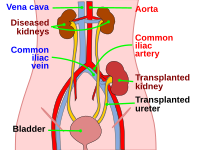
Photo from wikipedia
Objective There is solid evidence that kidney transplant (KTx) patients are susceptible to weight gain after transplantation. Post-transplantation obesity [body mass index (BMI) ≥ 30 kg/m2] seems to be associated… Click to show full abstract
Objective There is solid evidence that kidney transplant (KTx) patients are susceptible to weight gain after transplantation. Post-transplantation obesity [body mass index (BMI) ≥ 30 kg/m2] seems to be associated with higher risks of hypertension, dyslipidemia, diabetes mellitus, and cardiovascular events, while there are contradicting findings regarding the association between obesity and mortality, graft failure after transplantation as well as other variables. We aimed to evaluate the course of weight after KTx and to assess the prevalence of post-transplant obesity in a large sample of German KTx patients. Further, we focused on potential associations between weight gain, obesity, and BMI after transplantation with sociodemographic, medical, psychological [levels of anxiety and depression measured with the Hospital Anxiety and Depression Scale (HADS)], and donation-specific variables. Methods In a structured post-transplant care program 433 KTx patients were evaluated at Hannover Medical School. Information on the pre-transplant body weight/dry weight of dialysis patients was taken from the electronic patient charts. At post-transplant assessment body weight was measured in the transplant center. For statistical analyses, descriptive statistics, analyses of variance, tests for correlations, and regression analyses were used. Results Mean age was 51.3 years, 59% were male and 26.3% had ≥12 years of school attendance. Regarding somatic conditions 6.0% were suffering from type 2 diabetes mellitus, 6.9% were affected by new-onset diabetes after transplantation (NODAT), and the mean estimated glomerular filtration rate (eGFR) was 47.7 ml/min/1.73m2. The prevalence rates of obesity before and after kidney transplantation were 14.8 and 19.9%, respectively. This represents an increase of 34%. Obesity after transplantation was associated with higher rates of type 2 diabetes mellitus and of NODAT. Additionally, there was an association between increasing pre-transplant as well as post-transplant BMI and decreasing eGFR. Higher age and female sex were associated with higher rates of post-transplant obesity. Conclusions Our results suggest that obesity represents a serious problem in KTx patients, especially regarding the association between increasing BMI and decreasing graft functioning (eGFR). However, this aspect is often overlooked and information on effective treatment options for these patients are scarce making further research on this topic necessary.
Journal Title: Frontiers in Psychiatry
Year Published: 2020
Link to full text (if available)
Share on Social Media: Sign Up to like & get
recommendations!